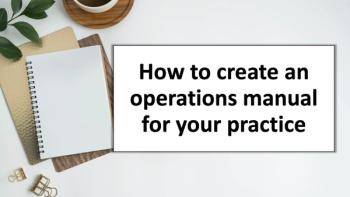
In Practice: ‘I’ve Got Some Bad News’
Delivering unpleasant clinical news is one of the toughest jobs in medicine. Here’s how to handle it with clarity and sensitivity.
Bedside manner: To patients, you either have it or you don’t. Do you need it? Frankly, it depends. Some patients will put up with an insensitive demeanor from a highly skilled specialist, while others consider a physician’s ability to empathize with patients to be an immutable part of patient care. Regardless, there is one instance when a diplomatic and insightful bedside manner becomes critically important: when you are the bearer of bad news.
“I’m not sure we realize how much of an impact how we deliver news makes,” says Muriel Gillick, a geriatrician in a large, palliative care-focused multispecialty practice in Boston. “I see lots of patients with various chronic diseases like MS who, years later, are still angry about the way they first learned they had the disease, how callous they thought the physician was, or how cold, or how unhelpful.”
Many physicians struggle with divulging bad news. Christina Puchalski, an internist with The George Washington University Medical Faculty Associates in Washington, D.C., believes the reason is largely due to the turn medical education has taken over the past century. “As science advanced and we discovered new illnesses and diseases, clearly that became the focus of the curriculum - to be good scientists and very skilled technicians
as well in diagnosing and treating our patients,” she says.
And that’s important, she says, but she adds that medical educators also assume that appropriate communication skills would come naturally to individuals who had chosen healing the sick as their professions. “In fact,” says Puchalski, “many times you would hear, ‘Well, I’m glad she became a pathologist because she really didn’t have great communication skills,’ the assumption being that those who have better communication skills will go into those fields where it’s most needed, and that’s the wrong assumption. Communication skills can be taught; they are not necessarily inherent.”
Robert Buckman, a medical oncologist at Princess Margaret Hospital in Toronto and the author of 14 books, including “How to Break Bad News: A Guide for Heath Care Professionals,” bears good witness to this assertion. He says his “old school” medical education left him completely unprepared when it came to confronting patients with discouraging lab or test results.
“Like everybody else, when I was an intern and a resident, I had no idea what to do,” he says. So he watched other physicians who he considered to be good communicators, and he copied their examples. Today, Buckman says he can handle even the most extreme patient reactions to bad news, including one case of a patient throwing a chair around his office. Buckman says he simply allowed the patient to “vent,” which was what that patient needed to do at that moment. Acknowledging a patient’s distraught state is one of the most effective methods of reaching out to them and responding empathetically.
Shift your viewpoint
So what makes bad news bad? “I think of it as anything I am talking to a patient about that could be bad news for them,” says Puchalski. “You have to view it through the patient’s perspective.”
“We can get a little cavalier about it,” she explains. “Most people agree that bad news is usually the very serious things, like a diagnosis of cancer, or ALS, or Parkinson’s, or something that’s potentially very life-limiting and serious. … But it could be that a diagnosis of diabetes brings to the patient a memory of an uncle losing his legs due to amputations, and they see this as a really horrendous, life-long illness.”
Of course, you have no way of knowing an individual patient’s preconceptions about any diagnosis you deliver. Still, you can at least try to avoid some of the more common errors doctors sometimes unwittingly commit during such patient encounters:
- Slow down. Many physicians mistakenly overwhelm patients with a glut of information about their diagnoses too quickly after “dropping the bomb,” says Gillick. She says that no matter how intelligent a person may be, it’s human nature to be unable to process an excess of information after receiving a negative diagnosis. Rather, convey explanatory details and treatment options in limited amounts - perhaps during a follow-up visit or personal phone call.
- Stay connected. Gillick say that “coming across as closing the door” is another common error physicians sometimes commit in the context of delivering bad news. “Giving their patients the idea that ‘this is it; this is done now’ leaves them with a feeling of abandonment,” says Gillick. “They need to feel that there is someone they can trust who can help them through this process.”
Reality check
Unfortunately, today’s volume-based practice model is conducive to committing such errors, says Puchalski. “Unless physicians are very lucky, most of them are seeing patients in very brief amounts of time, and that’s getting worse and worse,” she explains. “And you don’t want to open up a can of worms that you don’t have the time to give attention to. If you bring bad news and you have a 15-minute visit, for some people that might be fine, but for others, they may need to talk to you for 45 minutes or an hour. And you can’t schedule that. So what you’re naturally going to do is approach it in such a way that accommodates that 15-minute visit.”
Puchalski has some suggestions: Offer a very distraught or crying patient some private time while you see your next appointment. “If you have someone who can come and sit with them, or if you have a family member come in, there’s various ways that you can do it,” she says. Periodically check on the patient between other visits, try to meet their current needs as much as possible, and make a plan for following up. Sometimes Puchalski will even give her cell phone number to patients who she feels genuinely need it, telling them to call her if they continue to have a hard time and feel the need to check in. “And I’ve never, ever, ever had it abused by a patient,” Puchalski emphasizes. Never.”
If you’re not comfortable with this level of connection, then have a nurse or other appropriate staffer in your practice give the patient a call the following day.
Finally, alert a particularly panic-stricken patient of an “off-time” that you’re available, such as a half-hour before clinic hours. Puchalski invites such patients to her clinic at 7:30 a.m., before her first 8 a.m. appointment. “It doesn’t matter how you do it,” she says. “The important thing is to let patients know that you are there for them.”
But not all bad news visits need be long ones, adds Puchalski. Be “fully present” during such patient encounters, and you’ll find you can effectively fulfill patients’ emotional needs without falling behind schedule. Studies have indicated that patients who perceive their physicians as being fully present when they receive bad news often think the visit lasted longer than it actually did.
But what does this mean, being “fully present?” Buckman’s widely adopted six-point protocol, known by its acronym, SPIKES, explains it well:
- Setting - Secure a quiet, private room, sit down, turn off your beeper, and meet your patient’s eyes on the same level. Look relaxed, regardless of how you feel.
- Perception - Before divulging any information, assess what the patient may know or suspect about his diagnosis.
- Indication - Ascertain the level of information the patient wants. Some may indicate that they want to be spared the details at present, favoring a more generalized diagnosis. Others, particularly those from different cultures, may prefer not to know their own diagnosis, asking you to inform their families instead.
- Knowledge - Give the patient the medical facts in small chunks, making sure you don’t overwhelm him with information overload.
- Emotion - Buckman calls this “the most important step of all,” as it’s the time for listening - not telling. Acknowledge whatever emotion the patient expresses, especially if it’s strong. He recommends that physicians employ an empathetic response, in which they identify the patient’s emotion - be it fear, anger, or depression - and validate it with responses such as “This obviously comes as a major shock to you,” or “That bone scan was clearly not what you were hoping for.” Allow the patient time to digest the information, react to it, and express what she is feeling.
- Strategy and summary - Rather than ending the conversation by abruptly telling your patient her 15 minutes are up, assure her that she is not alone and that she may count on you for continued support. Establish your next steps, and summarize with a clear close to your discussion.
Buckman maintains that if the SPIKES approach is employed correctly, a patient visit shouldn’t take longer than 15 minutes. “The amount of time you spend doesn’t have any relationship to how satisfactory the interview is from the patient’s point of view,” he says. “Effective communication really does depend on you being a support to the patient, which doesn’t take more time than not being a support.”
Shooting the messenger
One of the most common human reactions to unexpected or startling news is to attack the news-bearer. Doubtless every physician, regardless of specialty, has been on the receiving end of this reaction. Indeed, with some people, you will be the target, no matter what you do. But you can blunt the unpleasant experience by taking proactive measures:
- Collapse the distance between you and your patient. Buckman says, “As you acknowledge how the patient is feeling, somehow you come around to their side of the desk, and you become their ally rather than an ally of the news.”
- Resist getting defensive in such situations (also a very human response). “Recognize that the patient is sad, overwrought, aiming at anything rather than the issue at hand,” says Gillick. For example, the patient might accuse you of neglecting to order some test or of making an error in judgment that somehow triggered the illness or brought it to light at a later stage. Stay calm, recognize the patient’s anger, express your sympathy for the situation, and attempt to steer the conversation back to the issue at hand.
And what about you?
Skills notwithstanding, coping with a crying, angry, or stunned patient can tax physicians, says Puchalski. And surely, our health system is sorely lacking when it comes to providing doctors the emotional support they may need to handle such situations. “When you say something to someone, and they are crying or telling you that this can’t be, unless you’re stone cold, you will have some reaction to that,” says Puchalski.
Simply recognizing that you are not a machine but a human being affected by your patients’ emotions and outcomes can vastly help you to help your patients. Also, seek out your peers or the other empathetic support sources to help you better cope with the pain and grief you may be feeling yourself.
Regardless of your individual approach to communicating bad news to a patient, it’s important to keep in mind that there is no “foolproof strategy” to guide you through this difficult aspect of patient care. “Sometimes medicine is almost like an algorithm,” says Gillick. “There’s a right thing to do for different medical conditions, such as for certain types of heart conditions … there are the right drugs to administer in the right doses and the right tests to do, and it’s all very straightforward.
But in this area, there is really no ‘right’ thing to do.” But if you gauge each situation to the best of your ability and customize your delivery according to individual needs, you’ll know how to best react to any possible response from your patients.
Barbara A. Gabriel holds an MA in English literature and is the associate editor of Physicians Practice. She has served as editor and writer for numerous healthcare publications during the past 10 years. She can be reached at
This article originally appeared in the February 2008 issue of Physicians Practice.
Newsletter
Optimize your practice with the Physicians Practice newsletter, offering management pearls, leadership tips, and business strategies tailored for practice administrators and physicians of any specialty.








